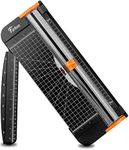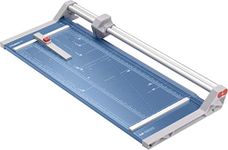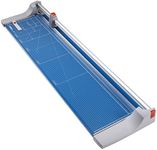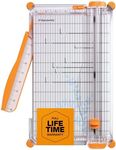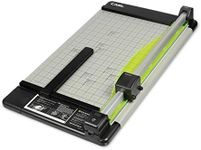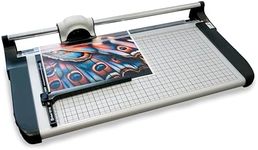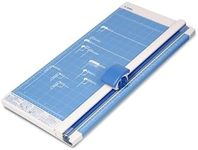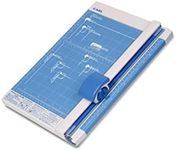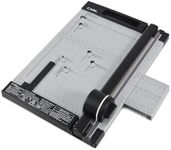Buying Guide for the Best Rotary Paper Cutters
Choosing the right rotary paper cutter can make a significant difference in the quality and efficiency of your paper cutting tasks. Whether you're a crafter, a teacher, or someone who frequently works with paper, understanding the key specifications of rotary paper cutters will help you select the best one for your needs. Here are the main factors to consider when choosing a rotary paper cutter.Cutting CapacityCutting capacity refers to the number of sheets a rotary paper cutter can cut at once. This is important because it determines how efficient your cutting process will be. If you frequently cut large stacks of paper, a higher cutting capacity will save you time. Cutting capacities can range from a few sheets to over 30 sheets at a time. For light use, such as occasional crafting or small projects, a cutter with a lower capacity (up to 10 sheets) may suffice. For more frequent or heavy-duty use, such as in a classroom or office setting, look for a cutter with a higher capacity (15 sheets or more).
Blade Type and QualityThe blade type and quality are crucial for achieving clean and precise cuts. Rotary paper cutters typically use circular blades that roll along the cutting edge. High-quality blades made from durable materials like stainless steel will stay sharp longer and provide smoother cuts. Some cutters offer self-sharpening blades, which can be a convenient feature. If you need precise and clean cuts for professional presentations or detailed craft projects, invest in a cutter with a high-quality blade. For general use, a standard blade will usually suffice.
Cutting LengthCutting length refers to the maximum length of paper that the cutter can handle. This is important if you work with larger paper sizes. Common cutting lengths range from 12 inches to over 24 inches. For standard letter-sized paper (8.5 x 11 inches), a cutter with a 12-inch cutting length is adequate. If you work with larger formats, such as legal-sized paper (8.5 x 14 inches) or larger craft paper, consider a cutter with a longer cutting length to accommodate your needs.
Safety FeaturesSafety features are essential to prevent accidents and injuries while using a rotary paper cutter. Look for features such as blade guards, safety locks, and non-slip bases. Blade guards protect your fingers from the sharp blade, while safety locks ensure the blade is securely in place when not in use. Non-slip bases keep the cutter stable during operation. If you have children around or if multiple people will be using the cutter, prioritize models with robust safety features to ensure safe usage.
Ease of UseEase of use encompasses several factors, including the cutter's design, weight, and additional features like measurement guides and alignment grids. A user-friendly design with clear measurement guides and alignment grids can help you achieve more accurate cuts. Lightweight models are easier to move and store, while heavier models may offer more stability. Consider how often you'll be using the cutter and whether you'll need to transport it frequently. Choose a model that balances ease of use with the features you need for your specific tasks.
DurabilityDurability refers to how well the rotary paper cutter can withstand regular use over time. A durable cutter is made from high-quality materials and has a sturdy construction. This is important because a more durable cutter will last longer and provide consistent performance. If you plan to use the cutter frequently or for heavy-duty tasks, invest in a model known for its durability. For occasional use, a less robust model may be sufficient, but ensure it still meets your basic needs for quality and performance.
